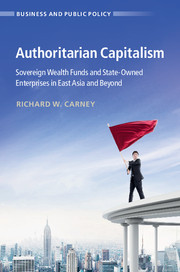Book contents
- Authoritarian Capitalism
- Business and Public Policy
- Authoritarian Capitalism
- Copyright page
- Dedication
- Contents
- Preface
- 1 Introduction
- 2 Theory
- 3 Global Patterns
- 4 East Asia Patterns
- 5 Narrow Authoritarian Regime: Brunei; Single Party Authoritarian Regime: China; From Single Party Authoritarian Regime to Democracy: Taiwan
- 6 Dominant Party Authoritarian Regime with a Weakly Dominant Ruling Party: Malaysia
- 7 Dominant Party Authoritarian Regime with a Strongly Dominant Ruling Party: Singapore
- 8 Conclusions
- References
- Index
- References
References
Published online by Cambridge University Press: 16 April 2018
- Authoritarian Capitalism
- Business and Public Policy
- Authoritarian Capitalism
- Copyright page
- Dedication
- Contents
- Preface
- 1 Introduction
- 2 Theory
- 3 Global Patterns
- 4 East Asia Patterns
- 5 Narrow Authoritarian Regime: Brunei; Single Party Authoritarian Regime: China; From Single Party Authoritarian Regime to Democracy: Taiwan
- 6 Dominant Party Authoritarian Regime with a Weakly Dominant Ruling Party: Malaysia
- 7 Dominant Party Authoritarian Regime with a Strongly Dominant Ruling Party: Singapore
- 8 Conclusions
- References
- Index
- References
- Type
- Chapter
- Information
- Authoritarian CapitalismSovereign Wealth Funds and State-Owned Enterprises in East Asia and Beyond, pp. 278 - 311Publisher: Cambridge University PressPrint publication year: 2018



